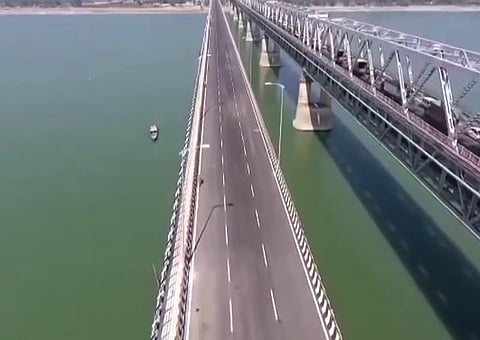
- Home
- Live Blog
- Breaking News
- Top Headlines
- Cities
- NE News
- Sentinel Media
- Sports
- Education
- Jobs

Shashanka Shekhar Goswami
(benediction@gmail.com)
The Brahmaputra River, with its dynamic flow and sediment discharge, is a unique waterway that presents both opportunities and challenges for development in Assam. The construction of the third bridge connecting Guwahati and North Guwahati aims to enhance connectivity and facilitate economic growth. However, this project raises critical concerns about the potential impact on North Guwahati and its surrounding environment, especially considering the unique characteristics of the Brahmaputra.
In 2022, a 13.5 km embankment was built in Morigaon, providing significant protection from the flooding that often devastates the region. This project serves as a model for how strategic planning can mitigate flood risks in vulnerable areas. However, in 2023, the old embankment in the Darrang district breached, causing extensive flooding. In response, the Water Resources Department proposed constructing over 20 km of embankments to protect critical areas, including the Garukhuti project. While these embankments are essential for flood management, they also raise concerns about how they might affect water flow downstream, particularly in Guwahati.
The third bridge, positioned alongside two existing bridges, presents unique challenges. The close proximity of these structures creates potential bottlenecks during flood conditions when the Brahmaputra’s water volume and sediment load increase dramatically. The river’s unpredictable behaviour during monsoons necessitates careful consideration of how this infrastructure will interact with its natural flow. If not managed properly, these bridges could restrict water movement, leading to overflow and affecting communities on the right bank, including North Guwahati and the historically significant Aswaklanta heritage site.
One of the primary concerns is how the bridge construction will interact with the Bharalu River’s water management systems. The Bharalu, often characterized by its sediment-heavy flow, connects to the Brahmaputra and has been a focal point for flood mitigation strategies. The Bharalu sluice gates are designed to regulate water flow between the two rivers, but increased sediment discharge during heavy rains could overwhelm these systems. This situation raises critical questions about the effectiveness of current water management practices and whether they are sufficient to handle the increased load resulting from the new bridge.
Moreover, if sediment build-up occurs around the bridge, it could impede the natural flow of the river, exacerbating flooding risks in North Guwahati. The bridges’ designs must account for potential sediment accumulation and ensure that they do not become points of blockage during flood events. This requires ongoing monitoring and maintenance to ensure that sediment management practices are in place, preventing the infrastructure from becoming compromised.
The environmental impact assessments conducted prior to the bridge’s construction should include comprehensive hydrological studies to predict how the new structure will affect water flow and sediment discharge. Understanding these dynamics is crucial for safeguarding North Guwahati and its surrounding areas from potential flooding. The government, along with the Environmental Impact Assessment (EIA) authorities, must implement rigorous monitoring protocols to ensure that the bridge does not inadvertently increase flood risks.
The construction company responsible for the bridge must also assure that all these concerns are adequately addressed and take full responsibility for the post-construction phase. This includes ensuring that the bridge can handle the expected load of floodwaters from upstream Assam without compromising the integrity of the structure or the surrounding areas. Any failure to account for these factors could have dire consequences for the residents of North Guwahati and the historical and cultural sites in the region. The Aswaklanta heritage site, located near the riverbank, represents an integral part of Assam.
Furthermore, regular maintenance of the Bharalu sluice gates and the surrounding water management infrastructure is vital. During peak flood periods, these systems must be capable of regulating the flow to prevent overwhelming the Brahmaputra. If the gates and pumps are not adequately maintained, the risk of overflow in North Guwahati increases, threatening lives, property, and significant cultural sites, including the Guwahati Gateway Ghat.
To effectively safeguard North Guwahati, flood barriers should be established to manage overflow risks. These barriers can help redirect floodwaters and prevent inundation in vulnerable areas. Additionally, embankments around North Guwahati must be routinely inspected and reinforced to withstand the Brahmaputra’s powerful floodwaters. This proactive approach can mitigate the risks posed by both natural events and infrastructural developments.
Moreover, the government must facilitate community awareness programs to inform residents about potential flood risks and the importance of engaging with ongoing maintenance efforts. Encouraging community participation in monitoring the river’s behaviour and advocating for timely interventions can significantly enhance local resilience against flooding. The involvement of local residents in flood management strategies ensures that the needs and concerns of the community are adequately addressed.
Ultimately, while the construction of the third Guwahati-North Guwahati bridge is essential for enhancing regional connectivity, it is imperative that this development does not compromise the safety and well-being of North Guwahati’s residents and cultural heritage. The unique challenges posed by the Brahmaputra necessitate a holistic approach to development, integrating flood management strategies, sediment control measures, and robust environmental assessments.
In conclusion, the question remains: Does the third Guwahati-North Guwahati bridge ensure protection for North Guwahati’s future? To answer this, we must evaluate the effectiveness of precautionary measures, ongoing maintenance practices, and community engagement in flood management. By prioritizing these aspects, Assam can work towards a sustainable future that balances infrastructure development with the need to preserve and protect its natural and cultural heritage. The river is a lifeline for the region, and its management must reflect its unique characteristics while safeguarding the communities that depend on it.
The implications of this bridge go beyond mere connectivity; they encompass the ecological integrity of the Brahmaputra and the historical significance of North Guwahati. Thus, collaboration between government agencies, construction firms, and the community is paramount to ensuring that the bridge serves as a lifeline rather than a liability for the region. Only with shared responsibility can North Guwahati navigate the complexities of development while safeguarding its future.